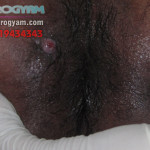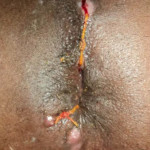Post Contents
Fistula-in-ano Classification Symptoms Treatment
WHAT IS AN ANAL FISTULA? Anal fistula, or fistula-in-ano, is an abnormal connection or channel like structure, between the surface of the anal canal and the exterior perianal skin.
Fistula-in-ano: An Ayurvedic Perspective
Bhagandara (Fistula-in-ano): An Ayurvedic Perspective
Definition of Bhagandara (Fistula-in-ano):
(Bhaga= Vagina, Darana= tear, spitting)
ते तु भगगुदबस्ति प्रदेशदारणाश्च ‘भगंदरा’ इत्युच्यन्ते ।
अभिन्ना: पिडका:, भिन्नास्तु भगंदरा: ।। (Su. Ni. 4/3)
This creates a tear in the area of Bhaga (Vagina), Guda (Anal canal & rectum) and Basti (Urinary bladder), so this is called Bhagandara.
Particularly, in the earliar stage when this is not open, called ‘Pidakaa’ (furuncle). Later on it will get burst and forms the Bhagandara (Fistula-in-ano).
- Kshar Sutra Treatment In High anal Fistula
- Kshar Sutra Treatment In High anal Fistula 2
- Kshar Sutra Treatment In High anal Fistula 3
- Kshar Sutra Treatment In High anal Fistula4
- Kshar Sutra Treatment In High anal Fistula6
- Kshar Sutra Treatment In High anal Fistula5
- Kshar Sutra Treatment In High anal Fistula8
- Kshar Sutra Treatment In High anal Fistula9
- Kshar Sutra Treatment In High anal Fistula11

Probable Causative Factors:
- Obesity
- Heavy diet
- Indigestion
- Suppression of natural urges
- Trauma
- Unhygienic condition
- Infection of the anal glands
- Worm infestation
- Ingestion of foreign bodies
- Excessive horse riding or bicycle riding
- Abrasion by stone, cloth and ground
- Constipation
- Excessive drinking of alcohol
- Straining
- Excessive coitus
Classification:
- According to Dosha Involvement:
- Ayurvedic classical texts have classified Bhagandara mainly in eight entities according to doshik involvement.
- शतपोनक भगंदर (Shatponak Bhagandara)- Vāta dosha dominance
- उष्ट्रग्रीव भगंदर (Ushtragriva Bhagandara)- Pitta dosha dominance
- परिस्रावी भगंदर (Parisravi Bhagandara)- Kafa dosha dominance
- शम्बूकावर्त भगंदर (Shambukavarta Bhagandara)- Tridosha dominance
- उन्मार्गी भगंदर (Unmargi Bhagandara)- Aāgantuja /Traumatic
- परिक्षेपी भगंदर (Parikshepi Bhagandara)- Vāta Pitta dosha dominance
- ऋजु भगंदर (Rhiju Bhagandara)- Vāta Kafa dosha dominance
- अर्शो भगंदर (Arsho Bhagandara)- Pitta Kafa dosha dominance
According to opening:
- Sushruta (School of Ayurvedic Surgery) again classified each type of Bhagandara according to its opening whether presents externally or internally. He used the terms,
- पराचीन (Parachina) or बहिर्मुखम् (Bahirmukham) – blind external and,
- अवाचीन (Avachina) or अंतर्मुखम् (Antarmukham) – blind internal.
According to modern contrive:
- According to modern texts, fistula-in-ano can be divided in two groups broadly, on whether the internal opening is below or above the ano-rectal ring respectively.
- Low level fistula
- High level fistula
- Low level fistula can be further subdivided into subcutaneous type, submucous type, intersphincteric type, trans-sphincteric type and supra- sphincteric type.
- High level fistula can be further subdivided into extrasphencteric or supralevator type, trans-sphencteric type and pelvi-rectal fistula.
Symptoms of Bhagandara (Fistula-in-ano):
- The main symptoms are boil around the anus, anal discharge and pain in anal region.
- Management (treatment) of Bhagandara (Fistula-in-ano):
- Local treatment:
- Aālepa (Paste of Ayurvedic herbal drugs)- for local application
- Upanāha (Warm poultice)- for local application
- Pariseka (Pouring of Ayurvedic decoctions)- for local application
- Swedana (Hot fomentation)- for local application
- Rakta vistravana (Blood letting)
- Varti application (Application of wick of cotton cloth mix with Ayurvedic herbal oils)
- General treatment:
- Follow the ‘Ayurvedic life style’ (look forward on the home page of this site)
- Apatarpana (Making the body thin by fasting)
- Vamana & Virechana (Ayurvedic Panchkarma Therapy/Ayurvedic Detoxification Programme)
Para-surgical procedures:
- Kshāra- sutra Therapy (Application of Alkaline Herbal Seton)
- Rakta mokshan (Blood letting)
- Agni karma (Thermal cauterisation)
- Kshāra karma (Application of Ayurvedic herbal caustics)
Surgical procedures:
- Bhedana karma- Fistulotomy
- Chhedan karma- Fistulectomy
Anal fistulae originate from the anal glands, which are located between the two layers of the anal sphincters and which drain into the anal canal. If the outlet of these glands becomes blocked, an abscess can form which can eventually point to the skin surface. The tract formed by this process is the fistula.
Ancient Ayurveda surgeon, Susruta has described five types of Bhagandara(Sataponak, Ustragriwa, Parisrabi, Sambukawarta, Unmargi). They have been classified according to the vitiation of the three doshas and the shape & site of the fistula tract.
CAUSES OF FISTULA?
- Anal fistulas commonly occur due to an anal abscess.
- An abscess is a collection of pus and infected fluid. An anal abscess usually develops after a small gland, just inside the anus, becomes infected with bacteria.
- A fistula may occur if an abscess has not completely healed, or if the infected fluid has not been entirely drained away.
- An anal fistula may also develop as a result of:
- a growth or ulcer (painful sore)
- a complication from surgery
- a congenital abnormality (a health problem that you were born with)
- Anal fistulae are also a common complication of conditions that result in inflammation of the intestines. Some of these conditions include:
- Irritable bowel syndrome (IBS): a chronic (long-term) disorder that affects the digestive system, causing abdominal pain, diarrhoea and constipation.
- Diverticulitis: the formation of small pouches that stick out of the side of the large intestine (colon), which become infected and inflamed.
- Ulcerative colitis: a chronic condition that causes the colon to become inflamed and can cause ulcers to form on the lining of the colon.
- Crohn’s disease: a chronic condition that causes inflammation of the lining of the digestive system.
SYMPTOMS OF FISTULA
- Anal fistulae can present with many different symptoms such as:
- Pain
- Discharge – either bloody or purulent
- Pruritus ani– itching around the anus
- Systemic symptoms if abscess becomes infected
DIAGNOSIS OF FISTULA
- Diagnosis is by examination, either in an outpatient setting or under anaesthesia. The examination can be an Anoscopy.
- Possible findings:
- The opening of the fistula onto the skin may be seen
- The area may be painful on examination
- There may be redness
- A discharge may be seen
- It may be possible to explore the fistula using a fistula probe (a narrow instrument) and in this way it may be possible to find both openings of the fistula




























Dr. Kya 1bar abses ka opretion hone ke bad hi pata chalta hai ki fistula hai ,jo 2opration me hota hai plz help